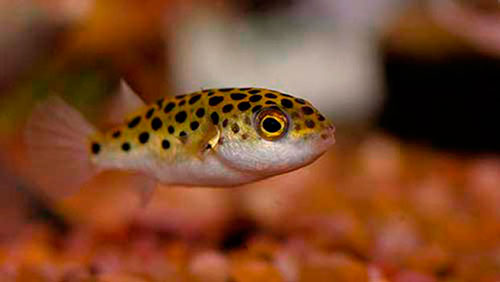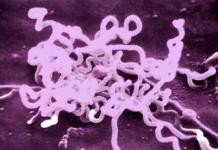Large aquarium fish need a spacious settlement in tanks of at least 300-500 liters. There are such large fish that get along with other large fish, and there are those who are better to settle separately. They need constant and high-quality care, and they require an order of magnitude more food than medium-sized fish. What kind aquarium fish large sizes suitable for home ponds?
Arowana. Red-striped mastacembelus. Red-tailed catfish
Arowana (lat.Osteoglossum bicirrhosum) is a large fish of the Arowanova family. Natural habitat - tropical waters of South America. Nowadays it is popular in amateur aquariums all over the world. It inhabits bodies of water with a water temperature of at least 22 o C. It is a pelagic fish species. It can live in rivers and lakes, where the concentration of dissolved oxygen is low. The body length of arowana is 90-120 cm. Body weight is 4.5-6 kg. The body is long, flattened at the sides. The scales are large, light, and have a silvery shimmer. The dorsal and anal fins are narrow and long, almost coinciding with the caudal fin. It can jump out of the water at a distance of three meters. It is an omnivorous fish. In the aquarium it feeds on beetles, spiders, crabs, snails, frogs, and plants.
Red-striped mastacembelus (lat.Mastacembelus erythrotaenia) is a large aquarium fish that can only be populated into large tanks with a volume of at least 300 liters. At the age of mastacembel fry, it is a harmless creature 5-6 cm in size. But after a few months it will become a 20-cm "snake" that can grow up to 50-60 cm in length. Mastacembelus is characterized by interesting behavior - he loves to explore the aquarium and the behavior of his neighbors.

Compatible with large fish that are also mobile. There is aggression within the species itself, so it is often kept alone in aquariums. Over time, it can take food from a person's hands. Allowable parameters of the aquatic environment for the content: temperature 25-28 degrees Celsius, acidity 7.0 pH, hardness 5-15 o. Requires powerful aeration, filtration and water change every 7 days (25% of the total). Females are larger than males, becoming sexually mature at the age of 2 years.
See what the red-striped mastacembelus looks like.
Red-tailed catfish (Latin Phractocephalus hemiliopterus), or Orino catfish, is a large predator, which is best kept in an aquarium with a volume of 500 liters or more. The red-tailed catfish grows rapidly, and within a year its length will increase by 50 cm. Then it will grow by another 40 cm. The catfish of this species is an avid hunter, which at a young age is able to destroy the aquarium neighbors that will fit in its mouth. Such voracious fish are often kept separately from other fish, or with incredibly large fish (arowans, astronotuses, pseudo-Platistomas).
It is better to feed the red-tailed catfish with animal food. After buying a young catfish 6-8 cm in size, they give him bloodworms, squids, shrimps, cod fillets for food. Later you can give small fish, raw capelin, chopped. Catfish can get used to a person, take food from their hands, allow themselves to be stroked.

The pseudoplatistoma is striped. Shark catfish. Moray eel freshwater
Pseudoplatystoma striped (lat. Pseudoplatystoma fasciatum) is a large freshwater fish, which is also called "paddlefish". There are two pairs of antennae on the lower jaw, and one pair on the upper jaw. To keep fish, you need a spacious aquarium with a volume of 500 liters or more. Pseudo-Platystopa striped is a predatory fish. The color of the body is steel-gray, black stripes with branches and original patterns stand out along it. Active at dusk. Who does such a large pet get along with? It is advisable to settle her alone in a spacious tank. But the aquarium will need even more spaciousness, and a successful neighborhood will turn out only with fish at least a meter in length (the length of the pseudoplatistoma striped is 150 cm). The neighbors should have a tall body and an active, mobile disposition. These catfish also dislike aggressive fish. They lack scales, the skin is soft, which is easy to damage.

Pangasius Siamese, or shark catfish (lat.Pangasius sutchi) is a large freshwater catfish with a mobile character. The body is torpedo-shaped, the head is slightly flattened, the eyes are black and mobile. Outwardly it resembles a small shark. Adults are dark in color and have a silvery belly. Young catfish have several gray stripes along the body, the color of the whole body is bright silver.

Pangasius are voracious pets that can eat anything edible. You can give insects, worms, fish meat, shrimp, food with plant components, cereals (buckwheat, rice, oat in the form of cereals) as food. But it is important not to overfeed the catfish, and to do a fasting day once a week. The length of this fish in nature is 150 cm. In an aquarium it can grow 20-30 cm long. It is unacceptable to settle them in aquariums less than 150 liters, because they need a large swimming space.
Look at feeding large aquarium fish.
Freshwater moray eel is a fish with an interesting appearance, which can be found not only in marine aquariums. It lacks paired fins, the gills are pushed back. Instead of scales - skin, and the muzzle looks very frightening. Despite its appearance, moray eels are sensitive to environmental conditions and live in the aquarium for only 2 years. In the absence of shelter in the aquarium, a lot of mucus appears on the skin. The body color is gray, dirty brick, albinos are less common.

Moray eels can be kept in fresh water, but if their health worsens, better water salt with sea salt at a concentration of 5 ppm and higher. The allowed water temperature is 25-30 degrees Celsius. The aquarium should have aeration, good filtration, and sufficient cavernous cover. The reservoir must be covered with a lid, and the openings in the devices must be covered with a net. Body length - 70 cm. Moray eels live with large and non-aggressive fish, who love salted water. Can be kept in a species aquarium. You can feed adults with frogs, fish, shrimps 1 time in 7 days, young animals - three times a week.
If you want to decorate your aquarium with beautiful exotic fish with bright and sparkling colors, then this article 10 of the most exotic freshwater fish is for you.
There are several unique aquarium fish species to choose from for both beginners and advanced aquarists.
This article will present several varieties of exotic fish so that you can choose a pet for your aquarium.
belong to the genus cichlids, they are native to the Amazon basin. They are bright in color and round in shape (hence the name). They are popular with hobbyists for their variety of exotic colors.
Over the past 30-40 years, these fish have gained a reputation as an elite aquarium.
The most popular colors are red, blue and turquoise. They can grow to a fairly large size, adults reach a size of up to 25 cm in height and length.
Another main reason for popularity discus, this is their behavior in the aquarium, these fish can even recognize you when you approach the aquarium.

Some might say that he looks like a dinosaur with their large powerful jaws and razor sharp teeth. They are also native to the Amazon basin and can grow up to 120 cm in the wild and 76 cm in captivity.
These fish are large, so you will need to have a large aquarium at least 1.6 meters long and 1 meter wide to allow the fish to unfold easily.
These fish prefer to eat live food such as live fish, crabs, beetles, shrimp or frozen foodstuffs and granules.
Since they are large fish and consume a lot of food, they will produce a large number of waste, for this it is necessary to install powerful water filtration.
They will feel most comfortable if the conditions of detention are as close as possible to their natural habitat. Plants, sand and stones should be present in the design of the aquarium.
Some types such as silver arowana in the wild, it jumps out of the water to capture prey, so you need to be careful not to scare the fish away, so as not to fish on the floor later.

It is found in the waters of Indonesia and Thailand. They are also called fish tiger due to their large black stripes and tiger-like patterned bodies.
You will need a fairly large aquarium, because this fish can grow up to 65 cm. You should try to keep conditions similar to their natural habitat.
Plants and hiding places are a good idea as they like to sit in cover to attack their prey.
Despite its love of hunting, this fish is not aggressive and can be kept together with other peaceful fish. Their diet consists of frozen foods, pellets and live food.
4. Stalkers - hymantures

Also native to the Amazon River basin, Stalkers - hymantures are peaceful, omnivorous and prefer plenty of hiding places in your tank.
Some species Stingray - hymantury reach up to 1 meter in length, so it is necessary to take care of a spacious aquarium. It is also necessary to pay attention to the care of certain species Stingray - hymantures as their skin and tails are fragile, and in some species the tails are venomous.
There is no reason to decorate the bottom of the aquarium, but fine sand is necessary.
If you plan to share with Stalkers - hymantures other inhabitants in your freshwater aquarium, it would be better to choose larger, more peaceful and non-aggressive fish.

Originally from Mexico City and also known as mexican salamander... It is a very unique (and sometimes adorable) and exotic creature that is actually classified as amphibian (salamander).
They are carnivores and prefer to consume insects, worms and small fish. They can be kept with other large fish. As well Stalkers they have sensitive skin and therefore the bottom of the aquarium should be covered with smooth and fine sand.
You will need a minimum of 60 gallons of aquarium if you want to keep it in your home aquarium.
The water conditions in an aquarium are extremely important when it comes to maintenance. For correct maintenance, frequent water changes with mandatory quality tests are required.

This colorful yellow green fish originally from Southeast Asia. They are black and brown spots and have become popular in freshwater aquariums because of their interesting behavior and personality.
Although this fish has a lifespan of around 10 years, you will have to become a responsible aquarist because these fish have special needs and care instructions.
can attack and kill other fish in the aquarium. They are very aggressive. Optimal aquarium volume for keeping Tetraodona not less than 200 liters.

Cichlids Flower Horn originally from Malaysia. These cichlids are very popular with hobbyists for their large size and beautiful color combinations.
have a variety of colors in combination with red, pink, yellow and orange.
It is a predatory and aggressive species that prefers large aquariums, so it is a good idea to keep this fish alone.
prefer to eat food from pellets, flakes and live food. With good care, it grows up to 16 cm. Life expectancy is 5-8 years.

Cichlids native to the lakes of Malawi, East Africa. If you choose to contain cichlid in your aquarium, you will need to create certain conditions for the fish in order to cichlids were healthy and delighted you with their bright color.
Malawian cichlids are popular with hobbyists for their adorable colors and adorable demeanor. Most species reach a length of up to 30 cm. During stressful situations, they can change their color.
If you decide to have yourself cichlid, then you need to create conditions in the aquarium that are close to natural habitat.
Your aquarium should contain rocks and shelters, and coarse sand as a substrate. The water temperature must be stable and well filtered.
Unlike South American cichlids, East African cichlids must be housed in large enough groups of their species to prevent territorial disputes that can end very badly.

Blue lobster despite its name, it is a crayfish native to Florida. Blue lobster belligerent and appropriate precautions must be observed before placing it in common aquarium as this crayfish is omnivorous and can eat small fish.
They will grow approximately 12 to 17 cm long and will require an aquarium of at least 80 liters. Make sure your tank has hiding places and walking areas because this crayfish loves to explore.
With proper conditions and care, Blue Lobster can live for 5 years.

Another species of the cichlid family, native to South America. Popular with aquarists Tiger Oscar has orange and black patterns all over the body. Some Oscar varieties are dark in color with lighter stripes. There are even albino Oscars, reds, and yellows.
They can grow about 25 - 30 cm in length, so you need to wake up a fairly spacious aquarium of at least 200 liters. Due to their playful and aggressive nature, they can move decorative objects around the aquarium and uproot plants, so heavy decor and plants with powerful rhizomes will be needed.
Oscars are predators, and therefore any live food is a joy to them. If you plan to keep in your tank, keep it only with other South American cichlids.
Share your experience .
If you've had any experience with the fish listed in this article, please share your experience in the comments section below.
Aquarium fish are one of the most popular pets. They are relatively inexpensive, do not provoke the appearance and decorate even the most minimalistic interior. Large aquarium fish look much more attractive than small ones. Moreover, they are often less demanding to care for than small species. They differ only in that keeping such fish requires aquariums with a volume of 100 liters or more.
Peaceful fishFish that are not prone to quarrels with neighbors are more preferable for novice aquarists. When buying them, you do not need to think about who you can hook up with them. These types include:

Aggressive species of large fish
Unfortunately, not all breeds are willing to put up with weak companions. It is forbidden to settle predatory fish in the same aquarium with peaceful ones, since the latter will quickly die. Such "loners" include:

Hooking up the new kind into the aquarium, do not try to populate the entire purchased brood at once. Add one fish and carefully monitor its behavior for several days - this will avoid the death of the young.
They are beautiful and diverse. They come in a wide variety of sizes and colors. When creating a small freshwater or saltwater corner in your aquarium, it is very important to choose the right fish, including the size. What are the biggest fish?
Turquoise acara(Andinoacara rivulatus) is a large aquarium fish. The length of adults can reach 18-20 cm... Akars are not the brightest in color. Her body has a basic gray-green color with a slight turquoise tint. Turquoise akars are able to distinguish the owner from other people and even allow themselves to be stroked. They are not shy, sometimes curious. When a person appears, fish swim up to the glass and observe him. Akar is best kept in pairs or groups. Given their size, they need a spacious aquarium (the volume depends on the number of fish in it).
Cichlazomas severum, or false discus(Cichlasoma severum) is a peaceful fish. They can show aggression towards neighbors only during the spawning season. False discus have a laterally flattened body, the length of which up to 20 cm... They can be of a variety of colors. These bright, large fish prefer the lower and middle layers of the water. They need the same living conditions as most large aquarium fish.
Diamond, or pearl cichlazoma(Cichlasoma cyanoguttatum) is another member of the cichlid family. It changes the main background color depending on its state and state. environment... The color can vary from blue-gray to brown. All over the body of these large ( up to 23 cm) fish have small pearlescent spots. During the spawning period, diamond cichlamoses change their color to black and white.
Cichlazoma bee, or biocellatum(Nandopsis octofasciatum), like many other large fish, has a violent temper. She can deal with small fish and start quarrels with medium and large relatives. In addition, the plants, too, will not go unnoticed by these cichlazomas, reaching a length 20-25 cm therefore it is better to plant hard-leaved plants in pots. To reduce the aggression of fish, it is recommended to select an aquarium at the rate of 100 liters per 1 fish, as well as add animal feed to the diet.
Astronotus oscar, or ocellated astronotus, or peacock eye (Astronotus ocellatus), is a picky, slightly shy fish. In a natural environment, it can reach a length 40 cm, however, in aquariums, astrotonuses, as a rule, do not exceed 25-30 cm. It is recommended to keep these large fish in six or more individuals, separately from other fish, or in the vicinity of fish commensurate with them. The volume of the aquarium is defined as 100 liters per fish.
Piranha
Piranhas are one of the largest fish kept in captivity. These exotic fish with sharp teeth look inconspicuous, but the very content of piranhas in the aquarium is of particular interest to many hobbyists. predatory fish... Piranhas are body length up to 50 cm... They are demanding fish. They need to provide not only the necessary space, but also change the water by 30% every week, provide filtration and aeration of the water, monitor the saturation of the fish in order to reduce the risk of cannibalism.
Huaru(Uaru amphiacanthoides) - beautiful and large fish with a difficult "character". Uaru grow up up to 30 cm, but in aquariums they often do not exceed 18 cm. They need to maintain a dH level around 10, otherwise the uaru will start to hurt. The Huaru are predators, so meat must be included in their diet. But, despite being carnivorous, these large fish do not attack other fish in the aquarium (not small ones), but simply terrorize and oppress them.
Botsia clown(Botia macracanthus) are interesting, active fish. They have an original color, and their body length can reach 30 cm... Of course, in a small aquarium, the owners are unlikely to be able to grow such large battles. A notable feature of the behavior of clowns' fights is their "habit" of lying on their backs or on their sides. This often scares beginners, but don't rush to get the fish out of the water. Firstly, fighting clowns thus rest, and secondly, they have special thorns that can injure a person. It is better to keep clowns in a flock, and as neighbors it is worth picking up fish with medium activity.
Tilapia Buttikofer, or zebra tilapia(Tilapia buttikoferi) are aggressive fish that are recommended to be kept in pairs. With age, the character of these fish becomes even more quarrelsome and explosive. They cannot get along with fish of other species, as well as live in cramped conditions. In addition, they dig in soil by digging in plants, so it is better to fill the aquarium with artificial or floating plants. Buttikofer tilapia are of considerable size. Adults can be up to 30 cm... For a couple of such fish, an aquarium with a volume of at least 200 liters is required.
Brocade pterygoplicht(Pterygoplichthys gibbiceps) is a member of the chain-mail catfish family. They grow slowly and reach their maximum size by 5 years, with a total average life in an aquarium of up to 15 years. The length of adult brocade pterygoplichts is approximately 50-60 cm. They need a spacious aquarium (at least 200 l). In addition, these bottom giants are twilight, so they need shelter and driftwood where they can wait out the day.
Large fish only pass for large aquariums or artificial ponds that have enough room to swim freely. Also, the fish look spectacular, also emphasizing the material status of the owners, because the maintenance of large fish is associated with considerable costs.
P.S. Download a ready-made presentation for the school "The largest aquarium fish"
When reprinting this article, an active link to the source is MANDATORY, otherwise, the use of the article will be considered a violation of the "Law on Copyright and Related Rights".
Large aquarium fish can draw attention to their natures not only in size, but also in color, as well as body shape and other features. Oftentimes, larger fish can look more impressive than their smaller counterparts.
We offer you a photo with the names of large aquarium fish, which are most popular among aquarists, and not only beginners. It should be said right away that the species presented can live optimally only in large aquariums - a volume of 200 liters or more.
We tried to share large fish by group - first you can familiarize yourself with the list of large catfish and loaches, and below are other types of fish that need an above average aquarium volume to keep.
Large aquarium catfish
Pterygoplicht
Perhaps one of the largest fish among sucker catfish. This catfish can be safely called, for its ability to clean glass and objects from growth. The fish are very showy, but are often aggressive towards other species of similar size, so they need a large aquarium with shelters.
Baggill catfish, clarias
An interesting type of catfish that can grow to a relatively large size - up to 20-30 centimeters. These fish have a longitudinal serpentine shape of the body, and a large bundle of whiskers in the mouth area is their main sensitive organ of touch.
Red-tailed catfish
This one can be described in just two words - a large predator. It grows to a fairly large size, as a result of which it will be able to eat anything that is slightly smaller than itself. The fish is certainly spectacular - of blue color with a red tail, but requires certain conditions and approach to content.
Shark Catfish
These fish also have another name - pangasius. The fish is quite spectacular, has a body similar to a shark and the location of the dorsal fin, but this is where the similarities end. It can grow up to several tens of centimeters, and requires an aquarium volume of 400-500 liters.
Other large fish
Torpedo barbusLeptobarbs are one of the largest species of barbs, which in their natural environment can reach a meter in length. For keeping them at home, it is better to choose aquariums with a volume of 200-300 liters. This fish has a silver torpedo body with red fins, and loves to eat any aquarium plants.
Shark barbus
Another type of barbs, but which has a body that looks like a silhouette of a shark due to the shape and size of the dorsal fin. The fish is very beautiful in color - black and silver, grows up to several tens of centimeters in home aquariums.
Goldfish
There are many types of gold, including large ones. They also require special conditions, in particular volume. Goldfish, as a rule, are not aggressive towards other fish, but other types of fish can attack them and bite on their fins, so you should not put them on just anyone.
Carp are very popular large aquarium fish, and at the same time they are not whimsical enough. There are many colors of aquarium carp - from silver or gold, to bright red. These fish are very beautiful, and can grow in aquariums to impressive sizes.
Many consider discusses to be the most spectacular and beautiful fish... They can be of very different colors - green, yellow, blue. A school of such fish will become a real decoration of your large aquarium, especially if its volume is from 400-500 liters.
Cichlid fish. It looks very impressive - it has a black body with bright orange spots. Even a beginner in the aquarium business can handle the maintenance of this fish, of course, subject to all the necessary conditions and requirements.
Not long ago it was a rare fish, but today more and more people learn about it. The fish is becoming popular not only for its exoticism, but also for its body shape - a snake-like fish that can grow to a length of more than a meter in natural conditions.
Another spectacular serpentine fish, but it grows to a less impressive size than the avrovana. This fish lives on the bottom, and often sits in a shelter. Be careful with its content, as it can easily eat all the little things.
We tried to present you the most popular large aquarium fish with their photos and descriptions. You just have to make a choice in favor of this or that instance. And of course, don't forget to check them for compatibility in ours.



































